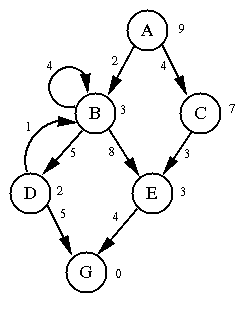-
Informed Search: Consider the following graph where nodes are states,
arcs are operators labeled with costs, values to the right of nodes are
their heuristic evaluations, A is the initial state, and G
is the goal state:

In (a)-(d), you will give the order in which nodes are goal-tested according
to different informed or heuristic search strategies employing
different ways of avoiding repeated states. List the order of node goal-testing
until the search terminates or 18 nodes have been listed. Ties in node
ordering are broken alphabetically by state label.
-
Greedy, no repeats
-
A/A*, generate all
-
IDA/IDA*, no cycles
-
Is our heuristic evaluation function h admissible? Why or why not?
-
Show why f is not monotonic.
-
Modify f according to the pathmax equation.
-
Multiple choice:
-
The drawback of A* is that
-
it takes more time than depth-first search
-
it takes exponential space (in the depth of the goal)
-
it may be difficult to find a (useful) admissible heuristic function.
-
both ii,iii
-
all of i,ii,iii
-
Select the most space conserving search of those mentioned below:
-
A* search with h(n) = 0 for all n
-
iterative-deepening search
-
breadth-first search
-
A* search with an admissible heuristic
-
One of the problems hill-climbing does not have is:
-
the local-minima problem
-
the plateau problem
-
the horizon problem
-
the ridge problem
-
TripleCross Challenge #2:
-
Create an admissible heuristic h for TripleCross. Explain
why h is admissible.
-
Program IDA* and compare its performance to iterative-deepending depth-first
search.
-
Use a weighted evaluation function and show how performance varies
for different weights.


